Review: LandingZone Docking Station provides a security and port solution for the MacBook ...
LandingZone's new USB 3.1 type-C Docking Station for the 13- or 15-inch 2016 or 2017 MacBook Pro doesn't cut corners and gives multiple USB ports and a SD card reader back to the user -- and AppleInsider has been using it daily for the last two months.
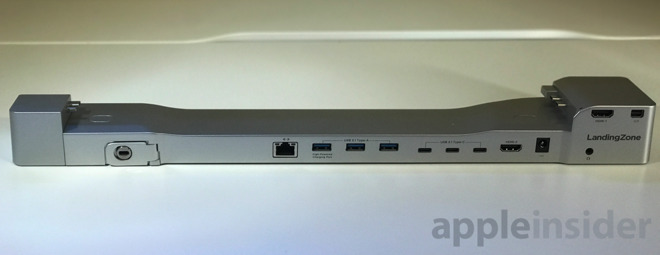
While not a Duo Dock of old with a VHS-like mechanism, the idea of an full enclosure for a computer granting more ports is similar. With the LandingZone Docking Station, users line up a Touch Bar-equipped MacBook Pro with the two USB-C ports on the left and one on the right, and push a lever on the back of the Docking Station to completely make the connection.
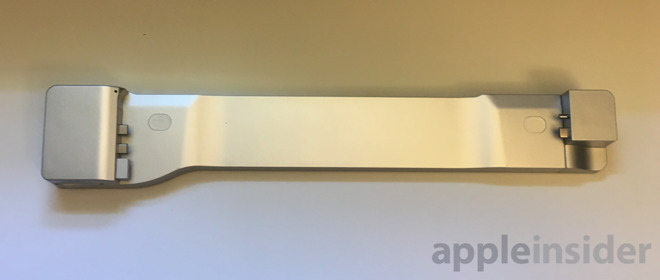
After the connection, all the ports in the dock are available. Plus, the underside of the laptop is more exposed, giving what is in essence a massive heatsink better airflow.
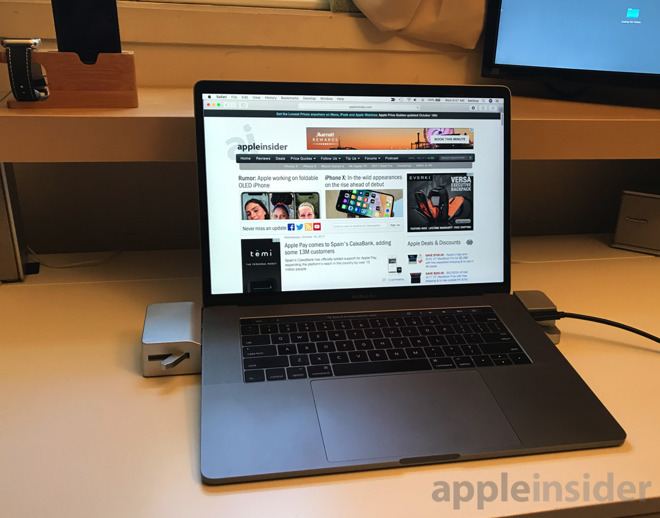
The plastic assembly gives the user a microSD and SD card reader, a Kensington lock slot, Gigabit Ethernet, a headphone jack, three USB 3.0 type-A ports, three USB 3.1 type-C ports on a hub, a stand-alone HDMI port capable of 4K resolution at 30Hz or 1080p resolution at 60Hz, and a combination HDMI or MiniDisplayPort capable of 4K at 60Hz.
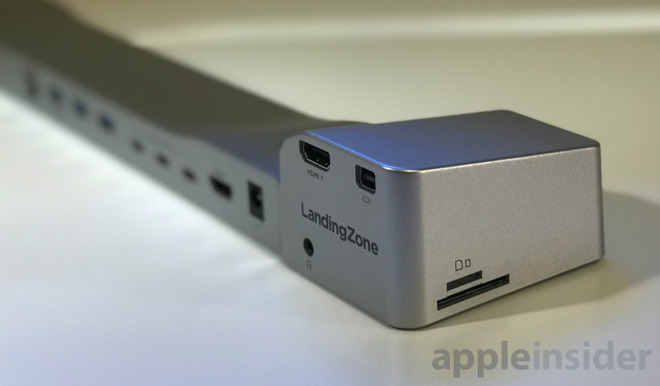
On the right side of the dock is a pass-through USB-C port -- specifically not a Thunderbolt 3 pass-through. In a scalloped cut-out, the MacBook Pro's Thunderbolt 3 port is exposed -- making it the only Thunderbolt 3 port accessible to the user after the computer is inserted.
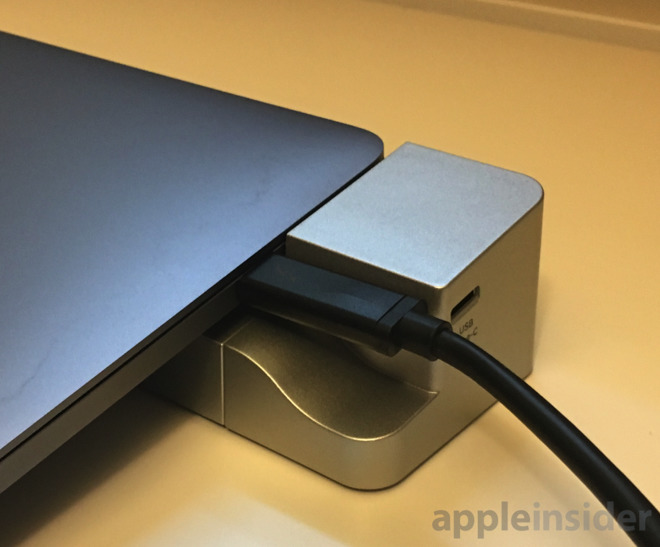
All of this is powered by a 97W power adapter, which supplies 60W of charging power. This is pretty good, but not quite enough for a 15-inch MacBook Pro to stay fully charged when under heavy CPU and GPU load.
Using our 100GB test file suites that we've used before with one with files all greater than 3GB and the other half large files, and the other half small ones, we were able to write to the array at 265MB/sec on USB-A, and 416MB/sec on USB-C.
This isn't a major problem for most home or educational users, but it might give "professional" users hell-bent on maximum speed pause.
However, the pass-through USB-C port on the right hand side of the dock as you face the open computer is a bit faster, transferring at about 550MB/sec. Obviously, the un-connected remaining Thunderbolt 3 port moves data at native speed -- but in our two months of testing, we reserved that port for our external GPUs.
The SD Card slot we couldn't get to transfer any faster than 51MB/sec.
The USB 3.1 Type C Landing Zone Docking Station, as with most Thunderbolt 3 docks, allows for multiple displays to be connected -- two to be precise. One HDMI port can technically do 4K, but only at 30Hz. The other connection uses USB-C alternate modes, and has physical connectors for a 4K display at 60Hz either on HDMI or Mini DisplayPort.
But, the fact that the pair of display connectors capable of 4K60 use USB-C alternate mode as opposed to a controller chip brings up an edge case -- many older Mini DisplayPort adapters for VGA or DVI displays don't work on the connector. It shouldn't be a major issue for most unless you're adapting so-called legacy displays with older connector types.
However, we'd like to see this go one step further. While the Landing Zone Docking Station allows for the Kensington Lock Slot to be used, in conjunction with that we'd like to see a screw-hole or similar way to fasten the device to a surface to further lean-into the security feature that sets it apart from "conventional" Thunderbolt 3 docks -- because the unit's $299 price doesn't.
If you need a solution that grants physical security for a MacBook Pro, in conjunction with multiple displays, USB-A ports, and a MicroSD slot then the LandingZone Docking Station is the only game in town.
If you don't hit all the checkboxes, though, there's no real reason to select it over any of the other Thunderbolt 3 dock options. But, if you're precisely that target consumer, then AppleInsider gives the LandingZone Docking Station:


While not a Duo Dock of old with a VHS-like mechanism, the idea of an full enclosure for a computer granting more ports is similar. With the LandingZone Docking Station, users line up a Touch Bar-equipped MacBook Pro with the two USB-C ports on the left and one on the right, and push a lever on the back of the Docking Station to completely make the connection.

After the connection, all the ports in the dock are available. Plus, the underside of the laptop is more exposed, giving what is in essence a massive heatsink better airflow.

The plastic assembly gives the user a microSD and SD card reader, a Kensington lock slot, Gigabit Ethernet, a headphone jack, three USB 3.0 type-A ports, three USB 3.1 type-C ports on a hub, a stand-alone HDMI port capable of 4K resolution at 30Hz or 1080p resolution at 60Hz, and a combination HDMI or MiniDisplayPort capable of 4K at 60Hz.

On the right side of the dock is a pass-through USB-C port -- specifically not a Thunderbolt 3 pass-through. In a scalloped cut-out, the MacBook Pro's Thunderbolt 3 port is exposed -- making it the only Thunderbolt 3 port accessible to the user after the computer is inserted.

All of this is powered by a 97W power adapter, which supplies 60W of charging power. This is pretty good, but not quite enough for a 15-inch MacBook Pro to stay fully charged when under heavy CPU and GPU load.
Speed testing
Using a USB-C SSD RAID capable of saturating a 10gbit connection, we tested the USB-A and USB-C ports. We don't believe that the ports are UASP -- and speed is slightly hampered as a result.Using our 100GB test file suites that we've used before with one with files all greater than 3GB and the other half large files, and the other half small ones, we were able to write to the array at 265MB/sec on USB-A, and 416MB/sec on USB-C.
This isn't a major problem for most home or educational users, but it might give "professional" users hell-bent on maximum speed pause.
However, the pass-through USB-C port on the right hand side of the dock as you face the open computer is a bit faster, transferring at about 550MB/sec. Obviously, the un-connected remaining Thunderbolt 3 port moves data at native speed -- but in our two months of testing, we reserved that port for our external GPUs.
The SD Card slot we couldn't get to transfer any faster than 51MB/sec.
Video connection
The USB 3.1 Type C Landing Zone Docking Station, as with most Thunderbolt 3 docks, allows for multiple displays to be connected -- two to be precise. One HDMI port can technically do 4K, but only at 30Hz. The other connection uses USB-C alternate modes, and has physical connectors for a 4K display at 60Hz either on HDMI or Mini DisplayPort.
But, the fact that the pair of display connectors capable of 4K60 use USB-C alternate mode as opposed to a controller chip brings up an edge case -- many older Mini DisplayPort adapters for VGA or DVI displays don't work on the connector. It shouldn't be a major issue for most unless you're adapting so-called legacy displays with older connector types.
Who wants one?
The best feature of the LandingZone Docking Station is the Kensington Security Slot. This allows for the Thunderbolt 3/USB-C MacBook Pro to be used in a public environment with legacy connectivity -- and be secured from casual theft.However, we'd like to see this go one step further. While the Landing Zone Docking Station allows for the Kensington Lock Slot to be used, in conjunction with that we'd like to see a screw-hole or similar way to fasten the device to a surface to further lean-into the security feature that sets it apart from "conventional" Thunderbolt 3 docks -- because the unit's $299 price doesn't.
Docks as far as the eye can see
There were just a couple of Thunderbolt 2 docks -- there just wasn't a lot of need for them. With the removal of "legacy" ports from the MacBook Pro, all of a sudden the concept had a renaissance.If you need a solution that grants physical security for a MacBook Pro, in conjunction with multiple displays, USB-A ports, and a MicroSD slot then the LandingZone Docking Station is the only game in town.
If you don't hit all the checkboxes, though, there's no real reason to select it over any of the other Thunderbolt 3 dock options. But, if you're precisely that target consumer, then AppleInsider gives the LandingZone Docking Station:
4 out of 5
Otherwise, look to other Thunderbolt 3 options that will give you the same port expansion in one, smaller package -- and only one occupied port.

Comments
I am ordering from the UK and don’t want to get it and then find it’s useless to me with complicated return shipping!
As you obviously have the dock can you offer any more info on this!?
In the open port just underneath it on the picture, it'll be 5K.
I wanted...
5K TB3 Support (rare - most docks only support up to 4K)
SD Card slot (micro SD is a big bonus as well as I often use them for my GoPro/DJI Phantom)
USB-C + USB-A expansion ports
Power passthrough (this one gives the full 85W from the LG, if I unplug the LG it drops to 60W from the dock - as expected)
3.5mm Audio Out
Gb Ethernet
HDMI port is a bonus but not critical
After LOTS of research I believe only the LandingZone fits all of the above.
Pros: Running 3 monitors including 4K 4:4:4 at 60 Hz. 1 MiniDP at 2560x1440@60Hz, 1 HDMI 1920x1080 @ 60 Hz, and one TB3 -> HDMI 2.0 cable at 3820x2160 @ 60 Hz (40" Samsung TV). The passthrough port on the right is not limited to 10G USB-C as the review states and another reader noted above. Its certainly a 40G TB3 port as amazing curved Sammy display works perfectly.
Kensington Lock: Need this for work. Mac's get stolen. IT/Security requuires locks to comply.
SD Cards/lots of ports(like that it has two HDMI or 1 DP'/1HDMU Flexibility).
Lots of USB ports
Lots of external USB ports
No Issues mainting 100% charge
Comes with power supply
CONS:
Its "fiddly" as noted above. There is no guidance mechanism like a PC dock. The mechanism will break IMO.
GigE does not work at corporate network. had to plugin Belkin USB-C. It sees a 1Gig connection but doesn't work. Messed with 802l.11x settings and no luck. Belkin GigE adapter out back of dock works well out the box perfect PNP.
Cheap POS construction. This plastic POS is poorly constructucted. It weighs nothing, its feels flimsy in hand, finish is sub par. Compared to the CalDigit TS3+ which is anodized aluminum and had much better asthetics. Its not just thats its plastic it not nice plastic it just feels loike cheap junk and i am concerned the clam shell mechanical mechanism will break soon. I can't see it lasting 1+ years in daily enterprise use. At $300 thats not acceptable. Have a hendedock on pre order still testing the the Caldigit.
Strange issues with monitor config docking and undocking. Dont see this with the TS3+ but not running 3 displays off multiple ports on that one either